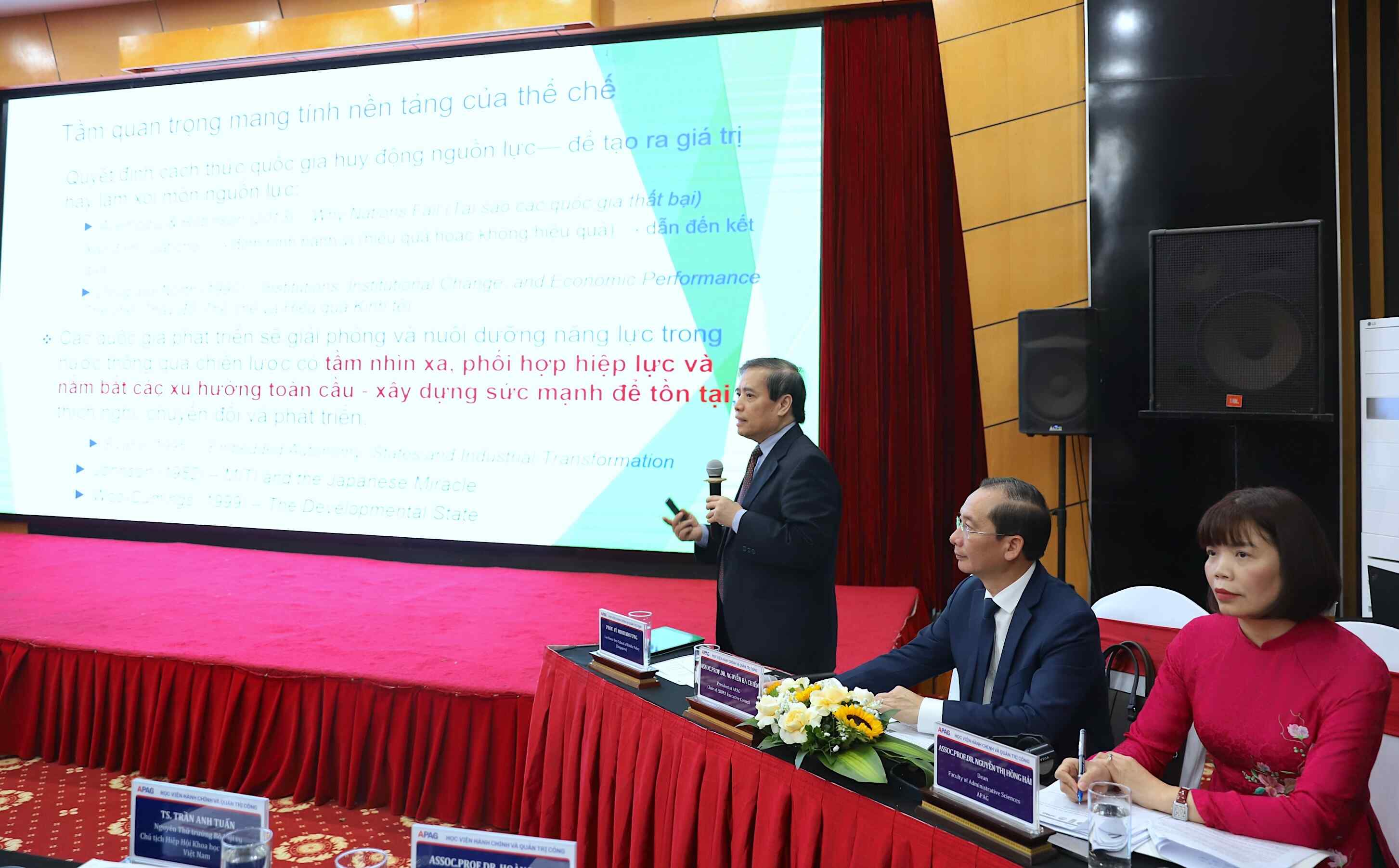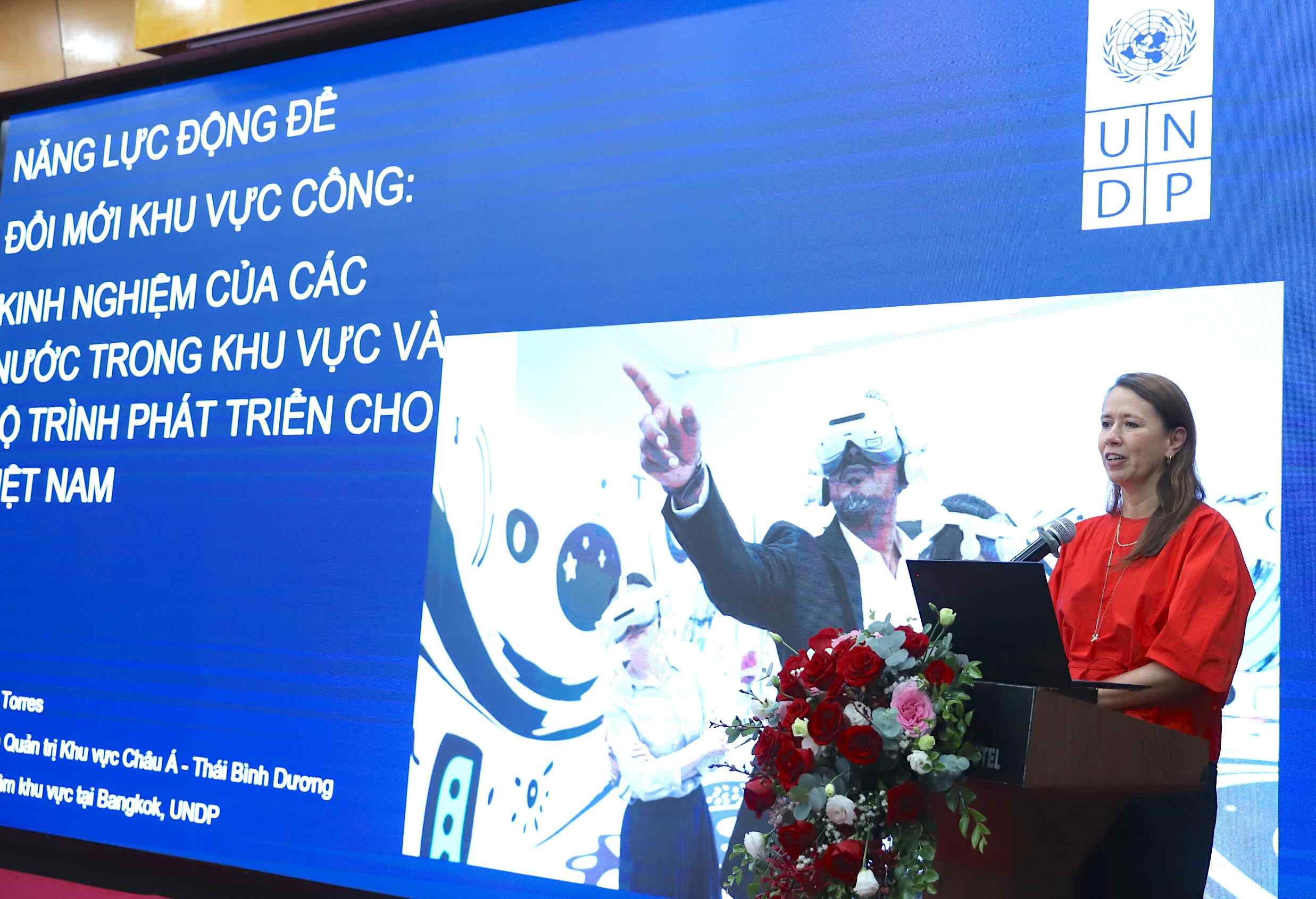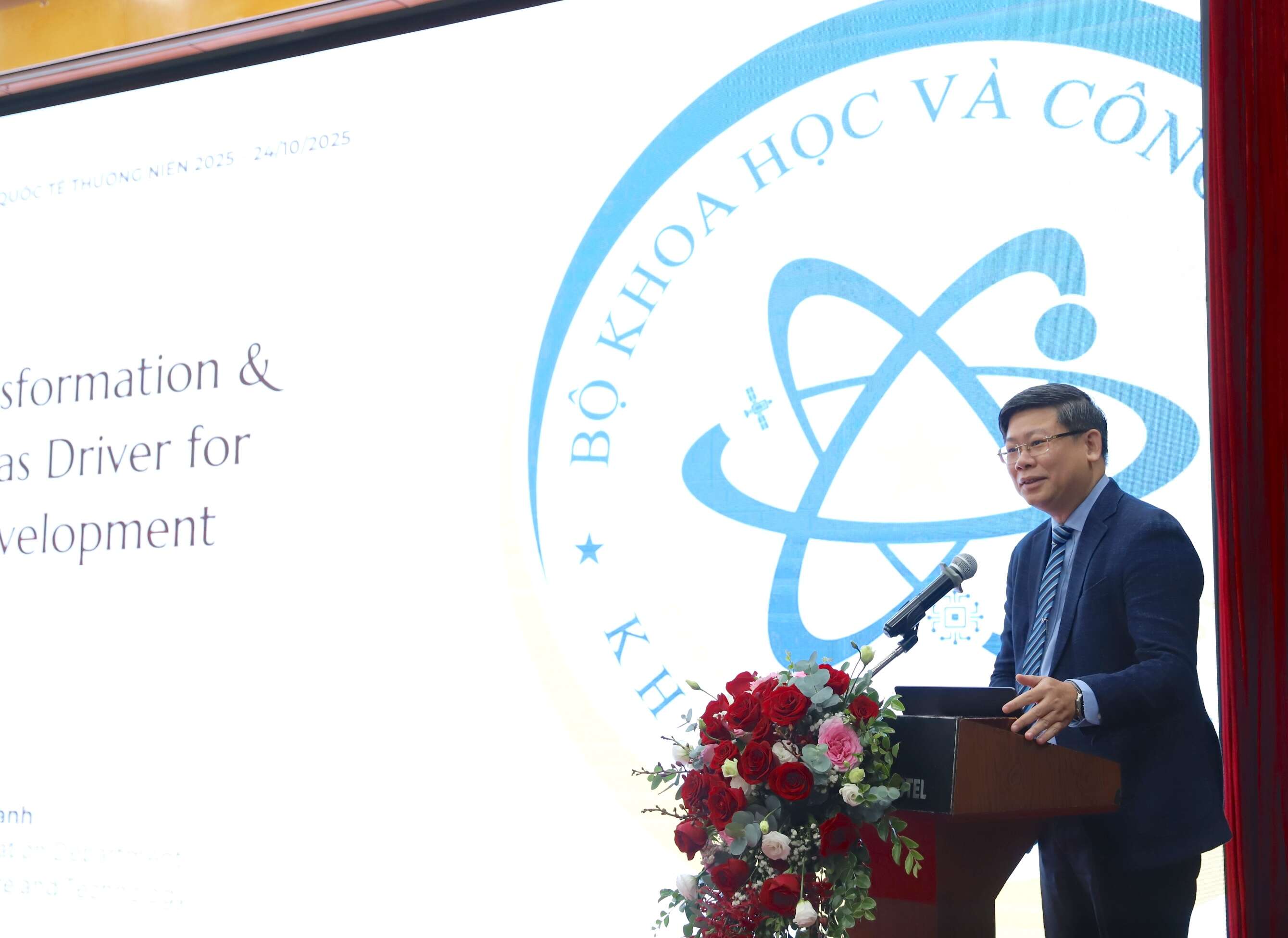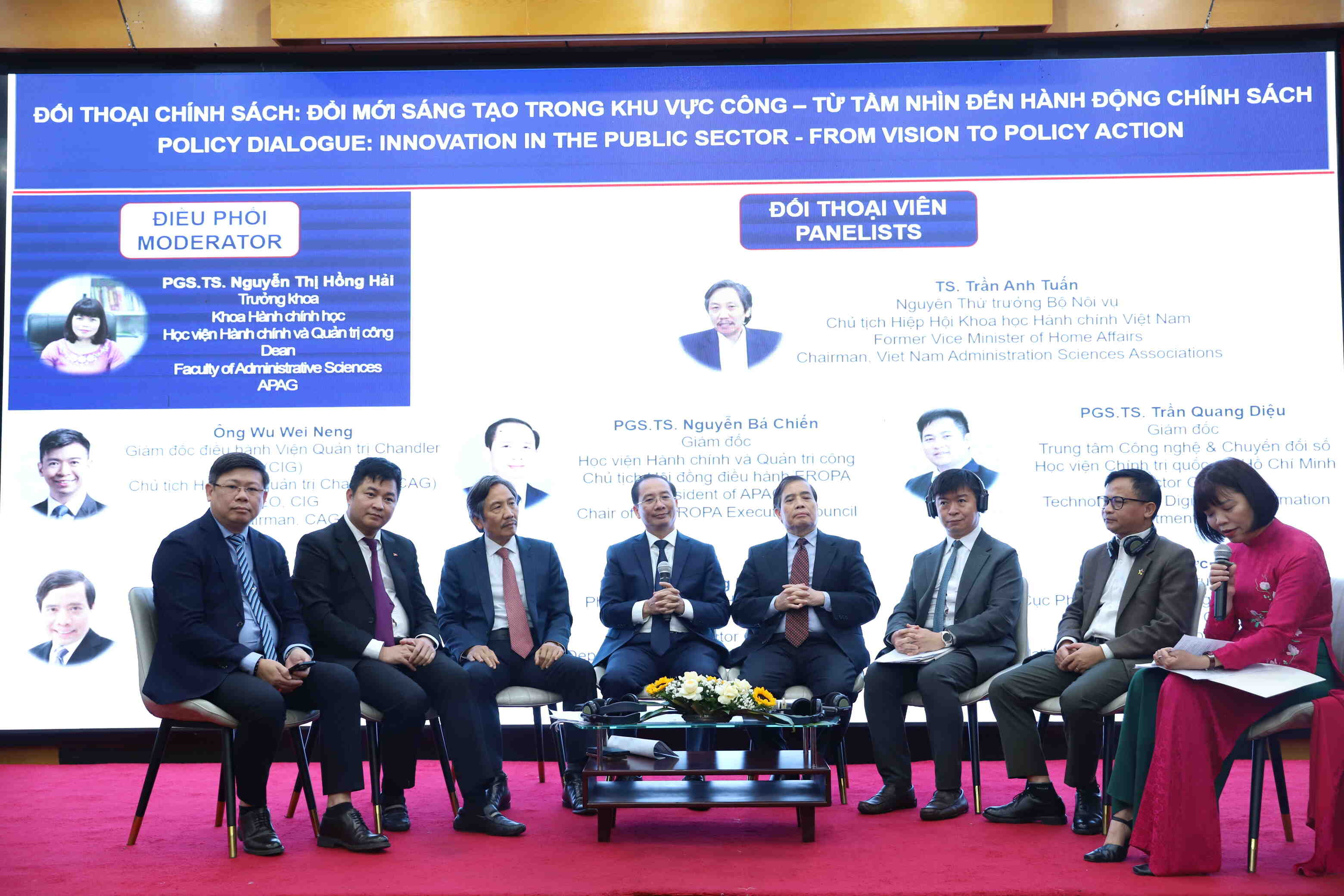As part of the 2025 Annual International Forum on Public Governance, on the morning of October 24, 2025, participants engaged in Session 1 “Innovation – The driving force for sustainable development in the new era.” Session 1 was co-chaired by Assoc. Prof. Dr. Nguyen Ba Chien, Prof. Vu Minh Khuong, and Assoc. Prof. Dr. Nguyen Thi Hong Hai; followed by Session 2: Policy Dialogue on the theme “Innovation in the public sector – From vision to policy action.”
SESSION 1: Innovation – The driving force for sustainable development in the new era
 Prof. Vu Minh Khuong, Lee Kwan Yew School of Public Policy.
Prof. Vu Minh Khuong, Lee Kwan Yew School of Public Policy.Prof. Vu Minh Khuong from the Lee Kuan Yew School of Public Policy delivered a presentation titled “Innovation in public governance – A strategic breakthrough for Viet Nam’s ascent to a high and sustainable growth trajectory.”
Prof. Vu Minh Khuong emphasized the crucial role of institutions in national development, determining whether the mobilization and allocation of resources create or erode value. He argued that a developed state must be built upon six key pillars: an effective central strategy, professional administration, results-oriented industrial policy, long-term investment in education and science–technology, modern infrastructure and finance, and international integration based on social trust.
Analyzing global trends, Prof. Vu Minh Khuong identified eight global megatrends shaping the 21st century, such as green transformation, digital transformation, globalization, urbanization, and the rise of Asia, referring to this as the “5.0 Era,” in which artificial intelligence becomes the driving force of a new civilization. Drawing from Viet Nam’s context, he proposed five institutional reform priorities focusing on building a developmental state, enhancing national governance, and driving innovation-led growth.
He also introduced a Five-pillar breakthrough framework for Doi Moi Phase II, consisting of: Vision 2045, global integration, institutional excellence, sustainable infrastructure, and human capital advancement. Alongside this, he proposed ten institutional reform initiatives, including establishing a National Development and Reform Commission, institutionalizing policy experimentation mechanisms, modernizing the legal system with AI, building a lean public administration, and accelerating digital transformation in the public sector.
He concluded that institutional reform and public governance innovation are strategic breakthroughs for Viet Nam to advance rapidly toward a modern, transparent, and humane governance system, aiming to achieve a prosperous, innovative, and sustainable Viet Nam by 2045.
 Ms. Diana Torres, Regional Governance Advisor, Asia-Pacific, UNDP Bangkok Regional Hub.
Ms. Diana Torres, Regional Governance Advisor, Asia-Pacific, UNDP Bangkok Regional Hub.Ms. Diana Torres, Regional Governance Advisor, Asia-Pacific, UNDP Bangkok Regional Hub, delivered a presentation titled “Dynamic capabilities for public sector transformation: Regional perspectives and paths forward for Viet Nam”. She emphasized the urgent need to build an anticipatory, adaptive, and agile governance model to help nations navigate challenges and seize opportunities amid the fast-paced and complex development landscape of the 21st century.
According to her, the Asia–Pacific region is falling behind in achieving the Sustainable Development Goals (SDGs), facing severe impacts from climate change, pandemics, demographic crises, and technological divides. In this context, dynamic governance capabilities, including anticipation, policy adaptability, and agile decision-making, have become essential to generating public value and promoting sustainable development.
Regarding Viet Nam, she noted that while the country has made notable progress in human development and governance, it needs to invest more heavily in three core capabilities, i.e., anticipation, adaptation, and agility, to achieve its goal of becoming a developed, high-income nation by 2045. UNDP recommends that Viet Nam prioritize four directions: promoting technology-driven growth, accelerating green and digital transitions, improving central–local coordination, and addressing challenges of rapid urbanization. She affirmed that building a dynamic and agile government is a prerequisite for Viet Nam to successfully achieve the SDGs by 2025.
 Assoc. Prof. Dr. Hoang Huu Hanh, Deputy Director General, Department of International Cooperation, Ministry of Science and Technology.
Assoc. Prof. Dr. Hoang Huu Hanh, Deputy Director General, Department of International Cooperation, Ministry of Science and Technology.Assoc. Prof. Dr. Hoang Huu Hanh discussed the role of science, technology, innovation, and digital transformation in national development. He reviewed Viet Nam’s impressive growth trajectory since the Doi Moi period, during which GDP per capita increased significantly thanks to economic restructuring and effective science–technology policies. He highlighted Resolution No. 57-NQ/TW as a strategic milestone identifying artificial intelligence (AI) as a breakthrough technology and a new engine of growth. Viet Nam aims to build a comprehensive digital government, digital economy, and digital society by 2030. The National AI Strategy sets out the goal of turning Viet Nam into a leading regional innovation hub by advancing AI applications in manufacturing, agriculture, healthcare, and education. Despite challenges in human resources and infrastructure, Viet Nam possesses key advantages in market potential, a young population, and international cooperation. He reaffirmed Viet Nam’s commitment to responsible AI development, emphasizing a human-centered approach that drives sustainable development and global integration.
 Mr. Wu Wei Neng, CEO, Chandler Institute of Governance.
Mr. Wu Wei Neng, CEO, Chandler Institute of Governance.The presentation by Mr. Wu Wei Neng, CEO of the Chandler Institute of Governance (CIG), Singapore, focused on the topic “National strategies for promoting innovation and sustainable development – the Singapore experience.” He emphasized that innovation is the cornerstone of a high-performing government, enabling the optimization of resources, improving efficiency, and maintaining sustainable growth. According to the Chandler Good Government Index (CGGI), the ability to design, coordinate, and implement policies effectively underpins good governance.
He highlighted that innovation is a prerequisite for effective government operations, from policymaking and crisis management to long-term reform. He identified three key success factors: leadership sparks, prototyping and experiments before scaling, and fostering a culture of innovation within the public sector.
He also introduced exemplary models such as Impact Canada, MindLab (Denmark), and Rwanda, which demonstrate how innovation can be institutionalized in public governance. In particular, Singapore’s experience serves as a leading example: innovation is embedded as a national strategy under the RIE2025 Plan, with the government investing 1% of GDP in research and technology, and promoting collaboration among the state, businesses, and academia. The government encourages civil servants to propose new initiatives, nurtures an innovation-led culture, and integrates creative thinking into education from an early stage. He also affirmed that innovation is the responsibility of the entire public system, enabling governments to adapt, learn continuously, and strengthen public trust.
SESSION 2: POLICY DIALOGUE
Session 2 featured a policy dialogue on the theme “Innovation in the public sector – From vision to policy action.” Panelists included Mr. Wu Wei Neng, CEO of the Chandler Institute of Governance; Prof. Vu Minh Khuong from the Lee Kuan Yew School of Public Policy, Singapore; Former Vice Minister of Home Affairs Tran Anh Tuan; Assoc. Prof. Dr. Nguyen Ba Chien, President of APAG and Chair of the EROPA Executive Council; Assoc. Prof. Dr. Tran Quang Dieu, Director General of the Technology and Digital Transformation Department, Ho Chi Minh National Academy of Politics; Assoc. Prof. Dr. Hoang Huu Hanh, Deputy Director-General of the Department of International Cooperation, Ministry of Science and Technology; and Mr. Pham Duc Nghiem, Deputy Director-General of the National Agency for Technology Entrepreneurship and Commercialization Development, Ministry of Science and Technology.
The session was moderated by Assoc. Prof. Dr. Nguyen Thi Hong Hai, Dean of the Faculty of Administrative Sciences, APAG.
 Panelists participate in the policy dialogue “Innovation in the public sector – From vision to policy action.”
Panelists participate in the policy dialogue “Innovation in the public sector – From vision to policy action.”At the session, panelists discussed the following key issues:
First, innovation was affirmed as a key driver of enhanced competitiveness, improved governance efficiency, and higher service quality for citizens. In national governance, innovation is not only about technology adoption but also about transforming mindsets, management models, and public service culture, enabling the administrative system to be more agile, transparent, and responsive to societal change. Creative applications in digital transformation, open data, and smart governance help improve efficiency, reduce costs, shorten decision-making processes, and foster a learning-oriented, proactive, and participatory public service culture. Innovation should be approached at three levels: (1) Mindset and innovation culture – shifting from a “management” mindset to one of “enabling and serving,” encouraging experimentation, controlled risk-taking, and outcome-based evaluation. (2) Institutions and policies – improving the legal framework for innovation, especially in data, technology, the digital economy, and AI; establishing financial mechanisms and public–private partnerships to stimulate innovation in the public sector. (3) Innovation capacity and infrastructure – developing innovative talent, building an ecosystem that connects the government, businesses, academia, and citizens, and accelerating digital transformation across the governance system. In this new era, public servants are not merely policy implementers but creators of public value, with core competencies in innovative thinking and adaptive creativity within a trusted, open, and results-oriented environment.
Second, awareness of innovation in Viet Nam’s public sector has improved significantly. Many policies of the Party and the State of Viet Nam emphasize the principle of “daring to think, daring to act, and taking responsibility for the common good,” while promoting creativity and improvement in public service delivery. Several ministries and localities have developed innovative administrative reform models, digital transformation initiatives, and smart management practices that deliver tangible results, reshaping how government operates and serves citizens. However, breakthroughs are still needed in institutional mechanisms, incentive systems, and public service culture to make creativity a core value of Viet Nam’s modern administrative system.
Third, measuring and evaluating innovation effectiveness in the public sector should begin by clearly identifying the subjects and scope of evaluation, with the agency leaders playing a decisive role. The outcomes of innovation are not only reflected in quantitative indicators such as KPIs but, more importantly, in changes in leadership mindset, management practices, and service quality for citizens. Innovation is a process of learning, experimenting, and creating new public value. Therefore, it should be assessed in an environment that encourages initiative and accepts controlled risk. The inclusion of innovation criteria in the performance evaluation system for civil servants, especially public leaders and managers, is a necessary step to foster a culture of innovation in the public service, inspire a spirit of boldness and accountability, and enhance public governance effectiveness.
Fourth, data serves as the foundation, institutions as the driving force, and digital citizens as the center of the digital transformation and innovation process in the public sector toward a smart, efficient, and sustainable national governance system. However, Viet Nam still faces many bottlenecks, such as inconsistent institutions and legal frameworks, fragmented data, a lack of mechanisms for data sharing and protection, limited digital human resources, and the persistence of traditional administrative mindsets. To move forward faster, Viet Nam needs to prioritize completing the national data legal framework, reforming public investment mechanisms for digital transformation, and establishing clear data accountability mechanisms at all administrative levels. It is also essential to strengthen citizens’ digital capacity and trust by developing universal digital skills, building a unified, secure, and user-friendly citizen data infrastructure, and ensuring privacy and information security.
Fifth, establishing policy sandboxes in the public sector is crucial for Viet Nam at this stage. A sandbox provides a controlled environment to test new ideas, models, and mechanisms, draw lessons before scaling up, minimize institutional risks, and foster innovation in public governance. Viet Nam can begin pilot sandboxes in fast-changing and high-impact areas such as digital transformation, open data, smart cities, digital finance, and online public services. To ensure effectiveness, a flexible yet robust legal framework should be designed, with clearly defined scope, timeframe, participants, and monitoring mechanisms, as well as risk exemptions that balance innovation with institutional safety.
Sixth, enterprises, especially digital technology companies, play a pivotal role in the public innovation ecosystem by providing technology, implementation capacity, and financial resources. To realize the goal of becoming a regional and global digital technology hub, Viet Nam should encourage investment and R&D, promote public–private partnerships, protect intellectual property, and foster a fair and competitive environment. Effective models of State–business–research institute collaboration include open innovation centers, interdisciplinary research programs, and co-creation mechanisms that enable all stakeholders to jointly develop solutions and test policies. Priority policies should include financial mechanisms supporting joint projects, flexible legal frameworks for innovation testing, and evaluation systems to scale up successful models, thereby making this collaboration a sustainable driver of public innovation in Viet Nam.
Seventh, Viet Nam needs to develop a national strategy for public sector innovation to guide action, create coordination mechanisms, and promote reform. Its key pillars should include flexible institutions and innovation-friendly policies, digital transformation and data governance, human capacity development, and a creative culture, as well as cross-sectoral and international cooperation.
In the afternoon, the Forum continued with two sessions:
Session 3: Strengthening the link between educational institutions and local governments in innovation
Session 4: Roundtable discussion “Building innovation capacity: The role of training institutions and local governments in the current context of Viet Nam”